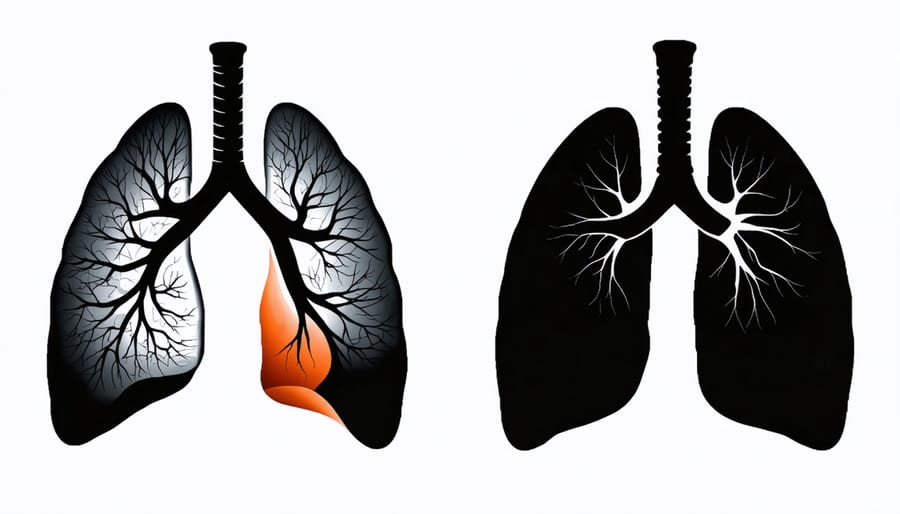
Vaping’s impact on athletic performance extends far beyond what many fitness enthusiasts realize, with research showing significant effects on cardiovascular endurance, muscle recovery, and oxygen utilization. While some athletes turn to premium vape store Canada products as an alternative to traditional smoking, the implications for fitness goals remain concerning. Recent studies reveal that e-cigarette use can reduce VO2 max by up to 7.6% in active individuals, potentially undermining months of dedicated training.
The intersection of vaping and fitness performance has become increasingly relevant as more athletes report using e-cigarettes, often unaware of how these devices affect their training outcomes. Whether you’re a competitive athlete or a casual gym-goer, understanding the relationship between vaping and physical performance is crucial for making informed decisions about your health and fitness journey. This article explores the scientific evidence behind vaping’s effects on athletic performance, recovery times, and overall fitness potential, offering practical insights for those looking to optimize their training results.
How Vaping Affects Your Workout Performance
Cardiovascular Impact During Exercise
During exercise, vaping can significantly impact your cardiovascular performance in several concerning ways. Many fitness enthusiasts report experiencing elevated heart rates during their usual workout routines after vaping, making familiar exercises feel more challenging. This increased cardiac stress can lead to premature fatigue and reduced workout quality.
Nicotine, a primary component in most vaping products, acts as a vasoconstrictor, narrowing your blood vessels and potentially limiting oxygen delivery to your muscles during exercise. This restriction can notably affect your endurance capacity, making it harder to maintain intensity during cardio sessions or high-intensity interval training.
Athletes who vape often notice a decrease in their blood oxygen saturation levels, which directly impacts aerobic performance. This reduction in oxygen availability means your muscles have to work harder to achieve the same results, leading to earlier onset of muscle fatigue and longer recovery times between sets.
Real-world experience from fitness community members shows that regular vapers typically struggle to maintain their previous endurance levels. Many report needing more frequent breaks during workouts and experiencing increased breathlessness during cardiovascular activities. Some have noticed their heart rate taking longer to return to normal after exercise, indicating compromised cardiovascular recovery.
For optimal athletic performance, maintaining healthy cardiovascular function is crucial. The impact of vaping on heart rate variability and blood oxygen levels can significantly undermine your fitness goals and training effectiveness.

Muscle Recovery and Strength
When it comes to building and maintaining muscle strength, your body’s recovery process plays a crucial role. Unfortunately, vaping can significantly impact this essential aspect of fitness. Research shows that nicotine, a primary component in most vaping products, can interfere with muscle protein synthesis – the fundamental process your body uses to repair and build muscle tissue after workouts.
Many athletes have discovered this impact firsthand, as demonstrated in one fitness recovery success story where switching from vaping to clean living led to notably improved strength gains. The nicotine in vape products constricts blood vessels, reducing blood flow to muscles during both exercise and recovery periods. This decreased circulation means less oxygen and fewer nutrients reach your muscle tissue when they need it most.
Additionally, vaping can affect your body’s natural inflammation response, which is necessary for proper muscle repair. While some inflammation is beneficial for muscle growth, the chemicals in vape products can disrupt this delicate balance, potentially leading to delayed recovery times and diminished strength gains.
To optimize your muscle recovery and strength development, consider these alternatives to vaping:
– Practice deep breathing exercises
– Stay properly hydrated
– Focus on quality sleep
– Maintain proper nutrition
– Use proven recovery techniques like foam rolling and stretching
By prioritizing these healthy practices over vaping, you’ll create an environment where your muscles can repair and strengthen effectively, leading to better overall fitness results.
Long-term Fitness Consequences

Respiratory Health and Endurance
When it comes to respiratory health and endurance, vaping can significantly impact your fitness journey. Regular vaping often leads to reduced lung capacity, making it harder to maintain peak performance during cardio-intensive workouts. Many athletes report experiencing shortness of breath and decreased stamina within weeks of starting to vape.
The aerobic system, crucial for endurance activities, becomes compromised as vaping introduces various chemicals that can irritate and inflame the airways. This inflammation makes it more challenging for oxygen to efficiently reach your muscles during exercise, potentially affecting everything from your morning jog to high-intensity interval training.
Sarah, a marathon runner, noticed a dramatic decline in her running times after six months of regular vaping. “My usual 10K time increased by several minutes, and I found myself struggling to maintain my previous training intensity,” she shares. This experience mirrors what many fitness enthusiasts discover: vaping can derail years of carefully built endurance.
Long-term effects on respiratory health can be even more concerning. Studies suggest that regular vaping may lead to chronic bronchitis symptoms and reduced lung elasticity, making it harder for your body to adapt to increasing workout demands. The good news is that many athletes report significant improvements in their endurance capacity within weeks of quitting vaping.
For those serious about their fitness goals, protecting your respiratory health is crucial. Consider that every breath during exercise should support your performance, not hinder it. Making informed choices about vaping could be the difference between achieving your fitness potential and struggling to maintain basic endurance levels.
Athletic Progress and Plateaus
For athletes and fitness enthusiasts, progress is often measured in small victories and steady improvements. However, vaping can create unexpected roadblocks in your fitness journey, making overcoming fitness plateaus significantly more challenging. Many athletes report experiencing diminished endurance and slower recovery times after incorporating vaping into their lifestyle.
The relationship between vaping and athletic performance is particularly noticeable in cardiovascular exercises. Regular vapers often find themselves hitting performance walls sooner than expected, struggling to maintain the same intensity levels they previously achieved. This isn’t just about immediate effects – the long-term impact can be even more frustrating for dedicated fitness enthusiasts.
Strength training progress can also suffer. The reduced oxygen efficiency caused by vaping affects muscle recovery and growth, potentially leading to longer periods between strength gains. Athletes might notice that they’re unable to increase their weights or reps as consistently as before, despite maintaining their training routine.
What’s particularly concerning is how vaping can mask fitness improvements. While you might be putting in the same effort at the gym, the respiratory limitations from vaping could be preventing you from seeing the results you deserve. This often leads to motivation issues, as the disconnect between effort and results becomes more apparent.
The good news is that these effects are reversible. Many athletes report significant improvements in their performance metrics after reducing or eliminating their vaping habits. By focusing on clean breathing and proper recovery techniques, you can get back on track with your fitness goals and break through those frustrating plateaus.
Making Informed Choices
Alternative Stress Management Techniques
When stress hits during training, there are numerous healthy alternatives to vaping that can help you stay focused and energized. Deep breathing exercises, particularly box breathing (inhale for 4 counts, hold for 4, exhale for 4, hold for 4), can quickly calm your nervous system and reduce anxiety between sets.
Progressive muscle relaxation is another powerful technique that involves tensing and releasing different muscle groups, helping you maintain body awareness while relieving tension. This practice can be especially beneficial during cool-down periods or rest days.
Many athletes find meditation and mindfulness practices invaluable for stress management. Even five minutes of guided meditation before or after workouts can improve mental clarity and reduce cravings. Apps like Headspace and Calm offer sports-specific meditation programs.
Physical alternatives include light stretching, yoga flows, or taking a short walk outdoors. These activities provide similar stress-relieving benefits while supporting your fitness goals. Additionally, stress-busting foods like dark chocolate, nuts, and green tea can offer natural mood enhancement without compromising your training.
Consider joining a fitness community or finding a workout buddy who shares your health goals. Social support can significantly reduce stress while providing accountability and motivation. Remember, managing stress is a skill that improves with practice, just like any other aspect of your fitness journey.

Transition Strategies
Transitioning away from vaping while maintaining your fitness routine requires a strategic approach. Start by gradually reducing your vaping frequency, particularly around workout times. Many athletes have found that setting specific “no-vape” windows before and after exercise can lead to a successful lifestyle change and improved performance.
Replace the vaping habit with positive alternatives during your fitness journey. Try deep breathing exercises between sets, which can help manage cravings while improving oxygen intake. Keep sugar-free gum or healthy snacks in your gym bag to occupy your mouth when the urge strikes.
Schedule your workouts during times when you typically vape to create new, healthier associations. Morning exercises can be particularly effective, as they set a positive tone for the day before cravings kick in. Consider joining group fitness classes or finding a workout buddy who can provide support and accountability.
Stay hydrated and incorporate cardiovascular exercises that challenge your breathing capacity. This will help your lungs recover and remind you of the benefits of clean air. Start with lower-intensity workouts if you experience shortness of breath, gradually building up as your respiratory function improves.
Remember, progress isn’t always linear. Celebrate small victories and be patient with yourself as you work toward better fitness and health habits.
Real Athletes’ Experiences
The impact of vaping on athletic performance becomes strikingly clear through the experiences of real athletes. Take Michael, a former collegiate swimmer whose athlete’s transformation journey involved breaking free from vaping. “I noticed my endurance dropping significantly after I started vaping,” he shares. “My lap times increased, and I felt winded much faster than before.”
Sarah, a CrossFit competitor, experienced similar setbacks. “Within six months of starting to vape, my WOD times suffered dramatically. The worst part was feeling like I couldn’t catch my breath during intense workouts.” After quitting vaping, she reported a 30% improvement in her benchmark performances within just three months.
Professional rock climber James Martinez found that vaping affected not just his lungs, but his overall recovery time. “The difference was night and day,” he explains. “When I was vaping, I needed longer rest periods between climbing sessions, and my grip strength wasn’t what it used to be. Since quitting, my stamina has returned to its peak levels.”
Even recreational athletes have noticed significant impacts. Basketball player Lisa Chen discovered that vaping affected her game performance: “I couldn’t keep up with full-court plays anymore. My teammates noticed I was constantly out of breath. Quitting vaping was the best decision for my game and health.”
These testimonials consistently highlight common themes: decreased endurance, longer recovery times, and reduced performance quality. Many athletes report that after stopping vaping, they experienced improved breathing capacity, better endurance, and enhanced overall athletic performance within weeks to months of quitting. Their stories serve as powerful reminders that vaping can significantly compromise athletic goals and fitness progress.
As we’ve explored throughout this article, vaping’s impact on fitness and athletic performance is significant and multifaceted. The evidence clearly shows that vaping can compromise cardiovascular endurance, reduce lung capacity, and impair muscle recovery – all crucial elements for achieving optimal fitness results. The nicotine in e-cigarettes also affects heart rate and blood flow, potentially limiting your body’s ability to perform at its peak during workouts.
For those committed to their fitness journey, the path forward is clear. If you currently vape, consider developing a cessation plan with the support of healthcare professionals. Your fitness goals and overall well-being will benefit significantly from making this positive change. Remember that many athletes have successfully transitioned away from vaping and reported notable improvements in their performance, breathing capacity, and recovery times.
Take action by focusing on these key steps: gradually reduce vaping frequency, incorporate more cardiovascular exercises to rebuild lung capacity, stay well-hydrated, and seek support from your fitness community. Consider working with a personal trainer who can help modify your workout routine during this transition period.
The journey to peak fitness is challenging enough without additional obstacles. By choosing to prioritize your respiratory health, you’re making an investment in your athletic potential and long-term wellness. Your body will thank you with improved performance, faster recovery times, and better overall fitness results.

